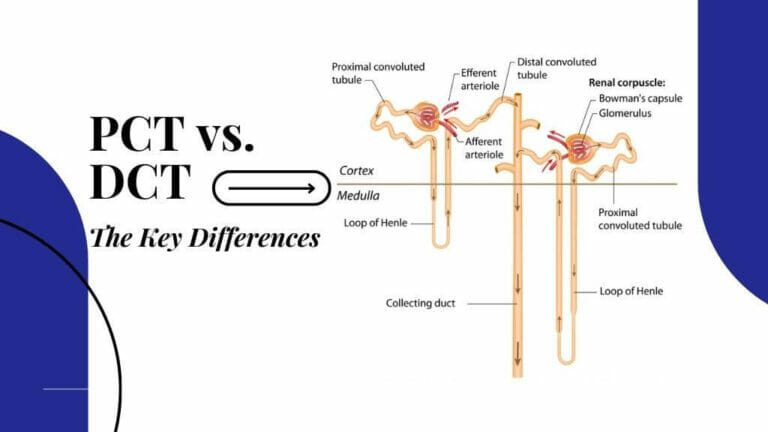The difference between PCT and DCT is that PCT performs reabsorption function in the nephron while DCT performs secretion function.
We have further listed all of the vital distinctions and key points of PCT and DCT below:
Table of Contents
What is PCT and DCT?
The working parts of the kidneys are called nephrons. These delicate tube structures, which are approximately one million strong and contribute to the production of urine, are present.
Nephrons make up most of the kidney, each with a glomerulus and a renal tubule.
The proximal convoluted tubule of the renal tubule enters the loop of Henle as the first segment, and the distal convoluted tubule, which is the second segment, is located between the loop of Henle and the collecting duct.
Three primary processes are necessary to produce urine: glomerular filtration, reabsorption, and secretion in distinct nephron regions.
DCT AND PCT perform reabsorption and secretion.
To maintain the pH and sodium-potassium balance in the blood, the Distal Convoluted Tubule (DCT) and Proximal Convoluted Tubule (PCT) both facilitate the reabsorption of sodium ions and water as well as the selective secretion of hydrogen and potassium ions.
Definitional Comparison Between PCT Vs. DCT
1. PCT

The PCT, or proximal convoluted tubule, is engaged in selective reabsorption. Microvilli offer a lot of surface area for absorption, and numerous mitochondria are found in PCT cells.
The blood actively transports sodium ions out of the cell. A gradient in concentration is produced.
As a result, chloride ions, amino acids, and vitamins are all co-transported via channel proteins as sodium ions enter the cell by diffusion from the lumen.
Then, within PCT cells, these chemicals spread into the blood. All glucose is typically reabsorbed. Additionally, some urea and water are also absorbed into the body.
However, neither uric acid nor creatinine is reabsorbed.
The PCT cells actively secrete creatinine into the lumen of the organ.
The proximal convoluted tubule (PCT) has specialized features to help with this since it has great power for reabsorption.
Simple cuboidal epithelial cells with a brush border around them enhance the surface area on the apical sideline inside.
Process Of Reabsorption In PCT
The PCT performs most of the reabsorption, which also secretes certain organic acids and bases, including bile salts.
PCT stands for proximal convoluted tubule.
Braun Marilla filtrate here travels from the Bowman’s capsule into the proximal convoluted tubule, while plumeria filtrate does the same.
The amount of glomerular filtrate pushed out of the glomerulus is huge; on average, it is about 180 liters every day, which is a vast amount of filtrate produced.
Therefore, the proximal convoluted tubule and your nephron’s function is to convert 180 liters into 1.5 liters, and the main process in this region is reabsorption. PCT is responsible for absorption.
Because the PCT reabsorbs most substances back into the blood, we would probably state that the proximal convoluted tubule is about reabsorption.
As a general rule, about two-thirds of many of the compounds are reabsorbed, or about 67, due to the capillaries that surround it and carry these substances away.
2. DCT

Water and sodium ions are capable of conditional reabsorption in the distal convoluted tubule. In order to maintain the pH and sodium-potassium balance in the blood, DCT is also proficient in selective hydrogen and ammonia secretion.
Functional Comparison Between PCT Vs. DCT
Function Of PCT
The PCT is in charge of reabsorbing 50–60% of the glomerular ultrafiltrate. As a result, it serves as a location for high-volume reabsorption but not for controlling the final composition of the urine. The collecting duct is in charge of the latter duty. The PCT reabsorbs the solute.
Function Of DCT
The DCT’s walls are made of laminar construction, which serves many crucial purposes. The proximal wall places a high priority on maintaining a stable blood calcium level. The distal wall is vital in the body’s salt and potassium balance.
Similarities Between PCT And DCT
- Both PCT and DCT take place in the renal cortex.
- Both are essential parts of the renal tubule of the kidney.
- The simple epithelium lines the lumen of the PCT and DCT.
- Both PCT and DCT are associated with reabsorption and secretion
- The blood pH is controlled by the interchange of hydrogen and bicarbonate ions, which occurs in both PCT and DCT.
- The formation of urine from the filtered plasma is caused by the actions of both PCT and DCT.
Read more: What is the Difference Between Chlorophyll and Chloroplast?
Main Difference Between PCT Vs. DCT

The difference between PCT and DCT is that PCT begins at Bowman’s capsule while DCT begins at the Henle loop.
PCT is more acidophilic, while DCT has a lower acidophilic value.
Another key difference between PCT and DCT is that it is easy to see the PCT’s limits and luminosity. In contrast, the DCT’s lumen and limits are less obvious.
The PCT’s primary job is to reabsorb. While secretion is the DCT’s primary function.
The PCT secretes uric acid, creatinine, antibiotics, and diuretics. While the DCT secretes ammonia, hydrogen, and potassium ions.
PCT Vs. DCT: Formation
The difference between PCT and DCT is that Cuboidal epithelium having microvilli makes up the PCT lumen. While the DCT lumen is composed of plain, microvilli-free cuboidal epithelium.
PCT Vs. DCT: Cytoplasm

The difference between PCT and DCT in terms of cytoplasm is that more cytoplasm can be found in the PCT’s epithelial cells. Less cytoplasm can be found in the epithelial cells of the DCT. PCT is long. Compared to PCT, DCT is shorter.
Comparison Table: PCT Vs. DCT
Highlighting the difference between PCT and DCT in the following table:
| PCT | DCT |
| The proximal convoluted tubule (PCT) is situated in between the Bowman capsule and the loop of Henle. | The distal convoluted tubule (DCT) is situated between both the loop of Henle and the collecting duct. |
| PCT begins at the Bowman capsule. | DCT begins at the loop of Henle. |
| PCT is more acidophilic. | DCT is less acidophilic |
| The main goal of the PCT is absorption. | The main function of the DCT is secretion. |
| PCT is lengthier in size. | DCT is shorter. |
Conclusion
The two twisted pieces of a nephron located in the renal cortex are PCT and DCT. DCT follows the loop of Henle, while PCT follows the Bowman’s capsule. While DCT is where secretion happens, PCT is mainly engaged in reabsorption. The key difference between PCT and DCT is that PCT examines how each component of the nephron functions.
Read more: Difference Between a Nucleotide and a Nucleoside?


